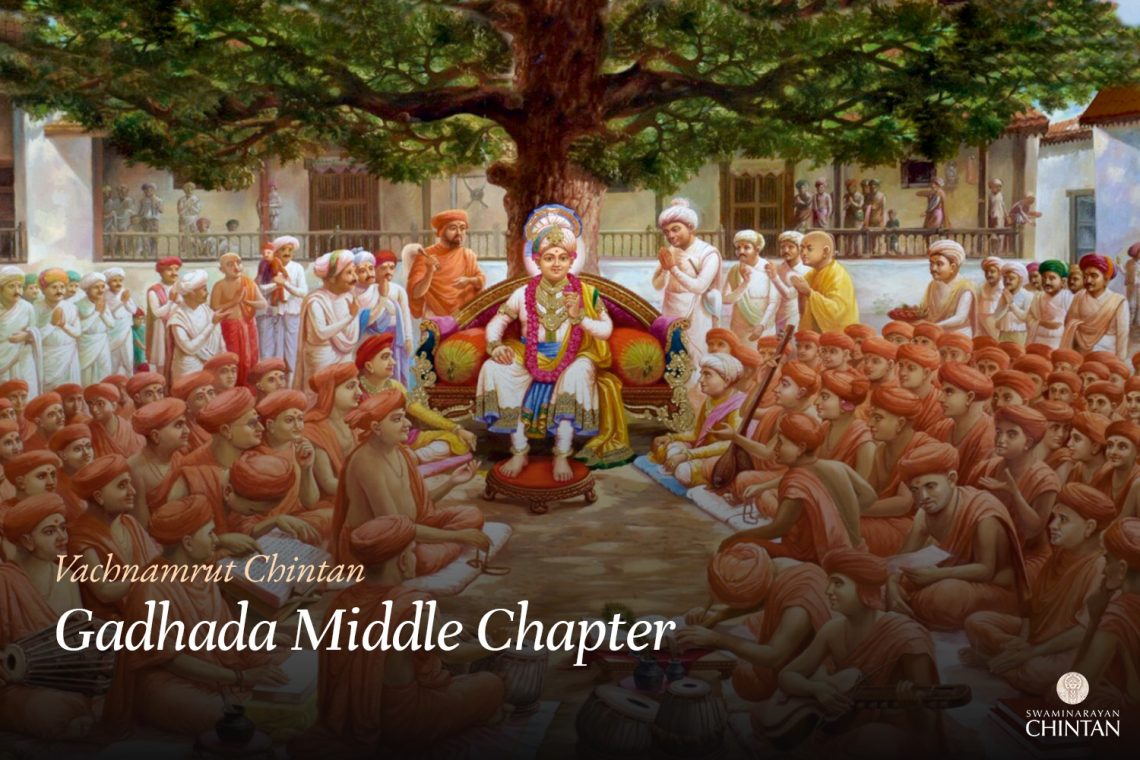Key Points:
- The elements are divided into two parts: the karan-rup (causal) elements, which are conscious, and the karya-rup (effectual) elements, which are inert.
- Liberation (mukti) is solely for the jiv (soul), not for the elements.
Explanation:
In this Vachanamrut, Shreeji Maharaj asks the paramhansas whether the 24 elements—such as the senses and antahkaran (inner faculty), which are products of maya (illusion) and associated with the jiv—are inert or conscious. The paramhansas responded that the elements are indeed conscious. Their reasoning was that when a person is asleep, if they turn in their sleep or respond to a mosquito bite, these actions seem to indicate that the body parts function independently, as though driven by their own consciousness.
Additionally, during the installation of deities, each body part—such as the eyes, ears, heart—is invoked individually. Similarly, parts of the Earth element and other devtas (deities) are worshipped individually. From these rituals, it seems that each element possesses its own independent consciousness, thus implying that the elements are conscious beings.
However, Maharaj raised a question: If these elements were conscious, then in the body there would not be just one jiv (soul), but 24 jivs corresponding to each element. In this scenario, when the jiv attains liberation, would these 24 jivs also achieve liberation along with it? If the jiv commits sinful acts, would the consequences of these actions be shared among all 24 jivs? For instance, if the tongue consumes alcohol, would the responsibility lie solely with the tongue’s jiv while the jiv of the stomach enjoys the benefits? This would imply a shared experience of the consequences, which is illogical. Additionally, when Narad and other souls attained liberation, it was only their singular jiv that was liberated, not 24 associated jivs.
Thus, Maharaj questioned this viewpoint and concluded that the elements are not conscious. The paramhansas could not respond satisfactorily.
Shreeji Maharaj then clarified that the 24 elements are of two kinds: karan-rup elements are conscious, while karya-rup elements are inert. At the time of creation, the 24 elements like mahat-tattva are conscious because they are governed by their respective deities. However, the elements in the body of the jiv are inert. They only appear conscious because they are pervaded by the jivatma’s power of knowledge. The jiv pervades the entire body through its power of knowledge, making the elements seem conscious. But in reality, the elements themselves are not conscious; the consciousness belongs to the jiv. When the jiv attains liberation, the inert elements remain behind, and only the jiv goes to the abode of God (Bhagwan).
The essence is that mukti is for the jiv alone and not for the inert elements. Therefore, one should not let the nature of the inert elements prevent the jiv from attaining liberation in the human
body. If liberation is missed, the loss is solely borne by the jiv. The pleasures and pains we experience are through the senses, but one must deeply reflect on this.
The saints provide a commonly used analogy: If a shepherd fails to control his sheep, they may stray into another’s field and eat the crops. When the field’s owner discovers this, they punish the shepherd, not the sheep. Similarly, when the senses and antahkaran indulge in worldly pleasures, it is the jiv that faces consequences, such as going to hell or rebirth. Therefore, one should deeply contemplate the true nature of the elements and secure their own path to liberation.
Glossary
| Karan-rup Elements – Causal elements that are conscious Elements like mahat-tattva, which are governed by deities and appear conscious due to their association with them. |
| Karya-rup Elements – Effectual elements that are inert The material elements present in the body, which are pervaded by the jiv’s consciousness but are themselves inert. |
| Jiv – Individual soul The living entity distinct from the body and mind, bound by past actions. |
| Mukti – Liberation or Salvation The state of being free from the cycle of birth and death, achieving union with the Divine. |
| Antahkaran – Inner faculties The mind, intellect, consciousness, and ego, which help in acquiring spiritual knowledge. |
| Maya – Illusion The material energy that entangles the Jeev in worldly existence and distracts from Bhagwan. |
| Mahat-tattva – The first element to manifest in the process of creation, forming the basis of material existence. |
| Inert Elements – Non-conscious, material components of creation |
| Consciousness – The knowledge and awareness of the jiv |
| Mukti– Liberation, Freedom from the cycle of birth and death |
| Shepherd Analogy – An analogy explaining responsibility The shepherd (jiv) is responsible for the actions of the sheep (senses and antahkaran), highlighting accountability. |
| Devtas – Deities, Divine beings that govern the elements |

